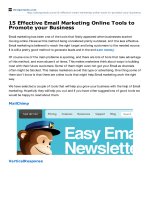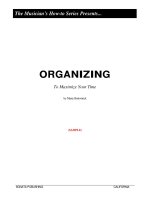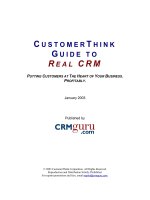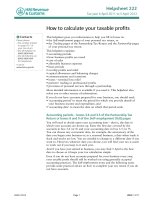SOCIAL MEDIA TIPS - Sharing lessons learned to help your business grow ppt
Bạn đang xem bản rút gọn của tài liệu. Xem và tải ngay bản đầy đủ của tài liệu tại đây (4.05 MB, 16 trang )
Sharing lessons learned to help your business grow
SOCIAL MEDIA TIPS
2
Social media! It seems
that you can’t turn a page,
scroll down a screen, or click
on a txt message without
hearing about it these days.
Hype aside, is it really important to your business? We at
Kodak think so and the reason is simple. It is where many
of our customers connect with one another to exchange
information, learn, have fun, and share — and we need to be
there for them.
Social media helps us in a number ways. We look at is as;
• a new platform to amplify our communications,
• a source of customer insight,
• a way to provide exposure to the great people who work in
our company,
• and, to have direct two-way engagement.
We started our e orts in this area more than four years ago
and as result have had a number of hits and misses. We like
the organic nature of social media and the fact that you can
try, measure, and iterate. We don’t hit homeruns all the time
and when we fail we want to, as we say in our o ce, “fail
faster” and get on to the next thing.
It has been our experience that many of the fears people
use as reasons to avoid the use of social media for their
company never materialize. “We will be fl ooded with support
requests.” “Employees might unintentionally leak sensitive
company information.” “We can’t really measure this so we
aren’t going to do it.” “People might say bad things about
us.” …and so forth. Guess what? People are talking about
your brand, products, and industry whether you want them
to or not. That train has left the station. Your customers have
raised their hand already when they purchased a product
from you or inquired about buying one. If you can help them
get the most out of it, get it fi xed, or just to say “thanks for
the purchase” that adds value.
Currently we make sense of more than 300,000 blog
comments, wall posts, tweets, forum mentions, videos, etc.
that mention Kodak on a monthly basis. In 2009, the term
“Kodak” saw 470,000,000 impressions in Twitter alone
(tweets x followers). Numbers like these cannot be ignored.
That is our brand people are talking about, a very valuable
asset. What do the social conversations look like in your
industry? Who are your fans? Detractors? Infl uencers?
Whether you are a big brand or a small print shop it
important for you to get a handle on the conversations
happening in the social space.
In this booklet you will fi nd many of the lessons learned we
have gained as a practitioner in the use of social media in
our marketing mix. In particular you will see tips from Jenny
Cisney, Kodak’s Chief Blogger and Beth LaPierre, our Chief
Listener. Yes, you read that title correctly — we
really
believe
in the power of listening.
I strongly believe that you and your business will benefi t
from direct interaction with both existing and potential
customers in the social space and hope that you fi nd these
tips of value.
Thomas Hoehn
Director, Interactive Marketing
Eastman Kodak Company
Twitter: @TomHoehn
LinkedIn: www.linkedin/in/thomashoehn
Kodak blog: tomhoehn.1000words.kodak.com
Got social?
S
that you can’t turn a page,
scroll down a screen, or click
on a txt message without
hearing about it these days.
2
Getting started
Before you jump in to social media think about some basic
questions:
• Why do I want to participate in social media?
• How can social media improve my business?
• How will social media be incorporated into my overall customer
experience?
Answers to these questions will help inform your engagement.
Let’s get going…
Set up profi les on Facebook, YouTube, and Twitter
social networks. It is best to use your name instead of an
obscure nickname that people may construe as spam.
Keep it as short as possible (e.g. John Doe instead of
Jonathan Michael Doe. Be sure to create an avatar (profi le
picture) when you set up your accounts. Nothing says
“newbie” more than having a default graphic inserted by
Twitter or Facebook.
Download an application like TweetDeck or Seesmic to
start “listening.” You can watch conversations on topics
you care about; printing, photography, your company name
or competitors, etc. If you see people’s “tweets” you fi nd of
interest click on their profi les and see what other tweets they
are making. If you fi nd them engaging, “Follow” them. This
way you will start to build your network.
Get a feel for the conversations. You will see that people
who come on too strong with marketing messages or
who misrepresent themselves are not treated too well by
the community. Think of the conversations you have in
your daily life. What is interesting? Boring? Overbearing?
Genuine? It is called social media after all.
Jump In. Now that you have listened you can be more
e ective in your participation.
Add value. People will want to know about your products
and services. You do not have to hit them over the head
to make them aware of them though. Give back to the
conversation. Share your observations on the industry, trends
that you are noticing, link to things you like, and dislike.
✓
✓
✓
✓
✓
3
4
The social media landscape
Wikipedia says: Facebook is a social networking website
that is operated and privately owned by Facebook, Inc. Users
can join networks organized by city, workplace, school, and
region. People can also add friends and send them messages,
and update their personal profi les to notify friends about
themselves.
Facts:
• Facebook has over 500 million users
• Facebook surpasses Google for weekly tra c in the US
• Facebook added over 200 million users in less than a year
• If Facebook were a country it would be the 3rd largest
• 60 million status updates happen on Facebook daily
• The average user spends more than 55 minutes a day on
Kodak uses Facebook to connect fans to our products and
brand. When we do a media campaign we use our main Kodak
Facebook presence to increase its audience base. If we created
di erent Facebook pages for each campaign it would dilute
our message and work against building a core fan-base.
Wikipedia says: “Twitter is a free social networking and
micro-blogging service that enables its users to send and read
messages known as tweets. Tweets are text-based posts of
up to 140 characters displayed on the author’s profi le page
and delivered to the author’s subscribers who are known
as followers. Users can send and receive tweets via the
Twitter website, Short Message Service (SMS) or external
applications.
Facts:
• Twitter has 106 million users
• Twitter’s search engine gets 600 million queries a day
• 2-3 new Twitter accounts are activated every second
• Twitter averages 55 million tweets per day
• There are almost 300,000 Twitter apps available
For your business, you can use it to quickly share information
with people interested in your company, gather real-time
market intelligence and feedback, and build relationships
with customers, partners and other people who care about
your company. As an individual user, you can use Twitter to
tell a company, or anyone else, that you’ve had a great, or
disappointing, experience with their business, o er product
ideas, and learn about great o ers.
There is a wealth of information about social media that exists both on and
offline. We gathered a few definitions and facts that may help you better
understand the landscape.
4
The social media landscape
YouTube
Wikipedia says: YouTube is a video
sharing website on which users can
upload and share videos.
Facts:
• YouTube is the 2nd largest search engine in the world
• The average online viewer watches 12.2 hours of online
video each month
• YouTube is the fourth most visited site on the internet
• The most popular YouTube video has 170 million views
• Every minute, ten hours of video is uploaded to YouTube
We created a KodakTube account to host videos we
were making for many purposes such as tradeshows,
commercials, how-to’s, interviews, and more. This provides
greater visibility to assets we were already creating.
BlogsBlogs
BlogsBlogs
Blogs
Wikipedia says: A blog is a type of website, usually
maintained by an individual with regular entries of
commentary, descriptions of events, or other material such
as graphics or video. Entries are commonly displayed in
reverse-chronological order. “Blog” can also be used as a
verb, meaning to maintain or add content to a blog. The
ability for readers to leave comments in an interactive format
is an important part of many blogs.
Fact:
• There are over 200 million blogs
• 54% of bloggers post content daily
• 25% of search results for the world’s top 20 brands are
links to user-generated content
• 34% of blogger post opinions about products and brands
• 78% of consumers trust peer recommendations only 14%
trust advertisements
Blogs are the heart of our social media e orts. We are not
tied to a platform owned by someone else or limited to 140
characters in our messaging. We use this has as a place for
more detailed information, stories, showcasing awards and
product reviews and more. We then link to blog posts from
Twitter and Facebook to give the content greater visibility.
5
6
Blog
1. Know what you are talking about. If you are going to work
with social media, be involved in social media. Start your
own Twitter account, Facebook page, read blogs and get
engaged. That is the best way to understand the culture,
tone, best practices, and protocol.
2. Always be transparent. When you are communicating in
social media say who you are and who you work for. Don’t
try to be sneaky and plant comments, don’t hire people to
go out and say nice things about you and stay away from
ghost writing. Be genuine and be real.
3. Be yourself. Readers can see through marketing talk. Be
passionate about what you do and let that show through
your personality. Let people see you as a person, not a
mouthpiece.
4. Post frequently. It’s a lot of work but don’t post to your blog
then leave it for two weeks. Readers won’t have a reason to
follow you on Twitter or check your blog if they can’t expect
new content regularly.
5. Add value. Share tips, tricks, and insights. People’s time is
precious and they need to get something out of the time
they spend with you. Make listening to you worth their time.
6. Respond. Answer questions, thank people even if it’s just a
few words. Make it a two way conversation.
7. Listen to what others have to say. Appreciate suggestions
and feedback, it will make what you do even better.
8. Learn from your mistakes. Don’t be afraid to say you were
wrong and be quick to make changes when you are.
9. Be external. You don’t have to be 100% internally focused.
Link to other blogs, videos, and news articles. Re-tweet
what others have to say.
10. Have fun. If you don’t like what you are doing, others will
notice it and won’t enjoy interacting with you.
10 Social Media Tips
from Kodak’s Chief Blogger
Follow on Twitter:
@KodakCB
6
Every month, there are about 300,000 new mentions of Kodak
on the Web. Here’s 10 tips to help you fi nd the needles in the
haystack of social content.
1. Find your audience. The fi rst thing you’ll want to do when you
put your ‘listening’ hat on is to fi nd out where your audience
hangs out online. Identifying the social networks and platforms
that your customers use adds focus to your e orts. For
example, if your organization is primarily B2B, then Facebook’s
probably not where you’ll fi nd your insights. Instead turn to
LinkedIn, Twitter or industry forums to fi nd out what matters to
your customers.
2. Identify your goals. Is your focus market research?
Competitive analysis? Customer support? Reputation
management? Align your e orts with real business objectives
early on to ensure a strategic approach to listening.
3. Defi ne success. What does success look like? This is
somewhat of a trick question as social technologies and
business needs are in a constant state of fl ux these days. For
me, success is getting the right information to the right people
at the right time. This could mean answering a customer’s
question via Facebook, getting customer insights to Marketing,
or routing product suggestions to product teams.
4. Evaluate tools and technology fi rst. You wouldn’t buy a car
without a test drive. The same thing applies to software and
managed services. Demos are great for getting an overview
but make sure you actually use the tool/technology/program
before you sign a contract. You also want to make sure
you’re evaluating it in the context of your unique needs and
requirements. Vendor sandboxes are great to play in, but
they’re usually simple executions that don’t take into account
complex, large-scale business challenges.
5. Play nice. Make friends with your peers and colleagues. Social
media’s changing so fast that it’s pretty much impossible to
know everything all the time. Surround yourself with people
who know more than you and ask questions.
6. Connect your data. Work hard to integrate social data with
traditional forms of data (CRM, Web analytics, brand metrics,
etc.). While it’s not easy, you’ll get a much clearer picture of
who your customers are and what they care about.
7. Don’t forget to listen internally. When I fi rst started at Kodak,
I spent the fi rst couple of weeks meeting with internal teams. I
listened to Product Managers, Marketers, Analysts, Engineers,
PR; even our front lobby greeter Angela. Find the people that
eat, sleep and breathe your products or services and spend
some time with them.
8. Quantity and quality. Make sure your data is representative
of not only volume of conversations, but the content of those
conversations. Do some human-sorted analysis to fi nd out
what people are talking about.
9. Make mistakes. Mel Brooks once said ‘As long as the world is
turning and spinning, we’re gonna be dizzy and we’re gonna
make mistakes.’ Accept, right up front, that you’ll make
mistakes. Just try to make them faster.
10. Don’t take it personally. Once you’ve launched your shiny,
new Facebook page not everyone’s going to be your friend.
You may (will) have to handle some negative comments and
sometimes even personal attacks. Remember to keep your
cool and know when to take a step back.
One last thing–keep it fun. Otherwise it’s just work.
I’m listening…
Find me on Twitter: @KodakCL
Listen Up: Getting the Most From
Social Intelligence
from Kodak’s Chief Listener
7
8
Tips from the industry
The interactive agency Razorfi sh released a report called “Fluent: The Razorfi sh
Social Infl uence Marketing Report” that is a must read for marketers wanting to get
smarter about social media. Here are a couple of highlights:
Brands must…
• socialize with their customers because “top-down” advertising isn’t going to work
by itself.
• develop a credible voice along the parameters of engagement, humility, and
authenticity.
• make their social relationships more symmetrical—that is, with value for both the
brand and the customer.
This Top 10 list for Twitter usage is also included in the report:
1. Become familiar with Twitter by reviewing, or following, the activities of
successful brands such as Dell (dell.com/twitter), Zappos (twitter.com/zappos)
and Comcast (twitter.com/comcastcares).
2. Listen to what is already being said on Twitter about your brand.
3. Identify initial objectives for using Twitter, including what would qualify as a
Twitter success story for your brand.
4. Look into competitive activities and potential legal considerations, especially
if there is already a Twitter account that uses your brand’s name or other
intellectual property associated with it.
5. Use the fi ndings to decide on the appropriate opportunity such as o ers or
community building, tone of voice and method of engagement—that may be
right for your brand.
6. Since Twitter is an ongoing activity—even if your company is only listening
in—dedicate a resource to monitor the conversations and competitors.
7. Map out a plan for the content you will share, including valuable initial content to
pique user interest.
8. Integrate your Twitter account throughout your marketing experience,
by embedding it as a feed on the company Web site, including its URL in
communications and so forth.
9. Maintain momentum by following everyone who follows you, responding to
queries and joining in conversations without being too marketing oriented.
10. Provide ongoing direct value through your tweets by continuing to listen, learn
and fi ne-tune your Twitter activities.
Sources: Fluent: The Razorfi sh Social Infl uence Marketing Report
8
We look at social media with a realistic lens. Companies
cannot “control” or “harness” conversations about their
products, people, or brand.
This graphic shows how we activate our organization
around social media. There are a few Kodak specifi c terms
shown here but the intent should still be applicable to any
businesses needs.
On some level all companies are publishers. Content
Creation, Distribution, Engagement, and Measures should
be key areas of focus.
Kodak Tactics
Some ways to measure your results…
• Direct sales and leads as a result of engagement
• Reverb – Message x Followers, Friends, BFFs, etc.
• Engagement – # of Videos x # of Views x Duration of video
• Quality vs. Quantity – “Content vs. impressions”
• Old measures vs. New – “Eyeballs and Ears vs. Hearts and Minds”
Four key metrics
• Reach
• Participation
• Infl uence
• Impact
9
10
Getting involved in social media.
Follow these procedures to comply with our one-voice
policy, and to protect Kodak and your own privacy
and resources.
We developed a social media policy for Kodak employees that you might
fi nd helpful for your organization. Our people from Marketing, Information
Systems, Legal, and Corporate Communications worked together to create
these 10 “rules.” We hope that you fi nd them helpful.
Kodak’s social media policies
Kodak has been growing its participation in social media to
strengthen our brand and our connection with customers and
key infl uencers.
Networking sites like Facebook, Twitter, and MySpace, news
sharing and bookmarking sites like delicious and Digg, and
photo- and video-sharing sites like fl ickr and YouTube can be
exciting new avenues for communication in our professional
and personal lives. Used responsibly, they provide an e ective
way to keep abreast of new trends and topics, and to share
information and perspectives. Kodak has thousands of
followers who have subscribed to keep up with Kodak blogs,
podcasts and “tweets” each day. The number continues to
grow, as does the number of viewers watching content on
KodakTube, our YouTube channel.
Given the reach of the internet, it’s important that when you
use these various media, you follow some basic procedures
that support our “one voice” policy as described in the
Business Conduct Guide. That policy applies to Kodak
employees when they blog or participate in social media
for work, but it should also be considered if personal blog
activities may give the appearance of speaking for Kodak.
Adhering to the following points in either situation will provide
protection for you and Kodak.
Maintaining a good reputation – yours and Kodak’s
1. Live the Kodak values. Always express ideas and opinions
in a respectful manner.
• Make sure your communications are in good taste
• Be sensitive about linking to content. Redirecting to
another site may imply an endorsement of its content.
• Do not denigrate or insult others, including competitors
In a real-life lesson, a worker in one company made
disparaging ‘tweets’ about a client’s headquarters city.
Needless to say, some of the client’s employees followed
the individual on Twitter and were o ended. Right or wrong,
they were upset not just with the individual, but with his
company as well.
2. Be yourself – and be transparent. The story above
illustrates how di cult it is to keep distinct lines between
your personal and professional life in the online world. Even
when you are talking as an individual, people may perceive
you to be talking on behalf of Kodak. If you blog or discuss
photography, printing or other topics related to a Kodak
business, be upfront and explain that you work for Kodak;
however, if you aren’t an o cial company spokesperson,
add a disclaimer to the e ect: “The opinions and positions
expressed are my own and don’t necessarily refl ect those
of Eastman Kodak Company.”
Also, only those authorized by a company may use that
company’s logos and trade dress in communications, so
be sure you do not include Kodak brand symbols or trade
dress – or that of other companies – in your personal blogs
or postings.
3. Protect confi dential information and relationships. Online
postings and conversations are not private. Realize that
what you post will be around for a long time, and could be
shared by others. Given that,
• avoid identifying and discussing others – including
customers; suppliers, your friends and co-workers –
unless you have their permission
• obtain permission before posting pictures of others, or
before posting copyrighted information;
• never discuss proprietary Kodak information, including
sales data and plans, company fi nances, strategies,
product launch information, unannounced technology or
anything considered “confi dential.”
To better understand what is – and is not – acceptable in
any type of communication, review the Kodak Business
Conduct Guide.
4. Speak the truth. If you are in a discussion that relates to
Kodak or its products, don’t make unsubstantiated claims
about features, performance or pricing. If you need to respond
or make a comment on something specifi c, verify details
through company-published information (such as product
pages on kodak.com). Also, because situations change, make
sure references or sources of information are current.
10
5. Keep your cool. One of the aims of social media is to
create dialogue, and people won’t always agree on an
issue. When confronted with a di erence of opinion, stay
cool. Express your points in a clear, logical way. Don’t pick
fi ghts, and correct mistakes when needed. Sometimes,
it’s best to ignore a comment and not give it credibility by
acknowledging it with a response.
6. Stay timely. Part of the appeal in social media is that the
conversation occurs almost in real time. So, if you are going
to participate in an active way, make sure you are willing to
take the time to refresh content, respond to questions and
update information regularly, and correct information when
appropriate.
Protecting your, and Kodak’s, privacy and resources
7. Be careful with personal information. This may seem
odd, since many sites are created to help promote sharing
of personal information. Still, astute criminals can piece
together information you provide on di erent sites and
then use it to impersonate you or someone you know – or
even re-set your passwords. Similarly, “tweeting” real-time
about your travels may confi rm you aren’t at home – letting
someone target your house. So, be careful when sharing
information about yourself or others.
8. Don’t be fooled. If you do post personal information
on a site like Facebook or Twitter, criminals can use it to
send you emails that appear to come from a friend or
other trusted source – even the site itself. This is called
“phishing.” The lesson is: Don’t click links or attachments
unless you trust the source. For example, be wary of emails
that say there is a problem with your account, then ask you
to click on a link and input your username and password.
The link may connect to a site that looks exactly like
Facebook, Twitter, your bank’s web site, but is really a fake
site used to get even more personal information. This ploy
can also be used to infect your computer with a virus or
keystroke logger.
9. Disable dangerous privileges. If a site allows others
to embed code – like HTML postings, links, and fi le
attachments – on your page or account, criminals can
use them install malicious software on your computer.
If possible, disable the ability of others to post HTML
comments on your home page.
10. Heed security warnings and pop-ups. There’s a reason
your security software provides warnings like:
• “A process is attempting to invoke xyz.exe. Do you wish to
allow this?”
• “The process ‘IEXPLORE.EXE’ is attempting to modify a
document ‘X.’ Do you wish to allow this?”
Never allow or say “yes” to such actions, unless you know
that they are safe.
Social media is growing at an amazing rate – and Kodak
is a leader in this area. The ability to engage online with
our customers, prospects and industry infl uencers is an
important part of our marketing and our brand strategy.
Following these procedures will help ensure we stay on
course as a company, and at the same time safeguard your
personal privacy.
11
12
Kodak social media activation examples
Kodak social media activation examplesKodak social media activation examples
We launched our pocket video camera line around the time we
became fi rst active in social media. After monitoring reviews and
comments in Twitter and YouTube we gathered a list of features
customers would like to see on the products and provided it back
to the product team. By listening to customers in social media
followup pocket video cameras included an external microphone
jack, fl exible usb arm, image stablization, a headphone jack, a
touch screen and even a better name.
Kodak was looking to engage young, socially connected
consumers. While tracking the conversation around Kodak in
posts on Twitter, it became apparent that the word “Kodak”
was being used by a di erent segment of pop culture we
hadn’t previously noticed. They were using the word “Kodak”
to express themselves as hot, fresh and hip. That was one of
the proof points that contributed to the So Kodak campaign
with three of today’s hottest young recording artists - Drake,
Trey Songz, Rihanna and Pitbull. They each each show in
their own unique way what it means to be “So Kodak.” The
campaign coincides with the introduction of the newest Kodak
Digital Cameras featuring Kodak’s exclusive Share Button.
The Share Button makes it easy for consumers to share their
pictures and videos with their social network.
Listen and Respond
Ask yourself
Are you missing opportunities by not listening?
Are key people in your organization aware of conversation
about your brand online?
12
Beyond your tradeshow fl oor
Kodak is using social media to expand its presence beyond
the tradeshow fl oor bringing our messages directly to people
worldwide.
We augment traditional press materials like releases and
spec sheets with blog posts and video interviews generated
directly from the show. We have seen tremendous results
with expanded coverage by both traditional and new media.
The successes we have seen in our communications and
coverage has reshaped the way we approach tradeshows.
Social media is now an important element of every show.
Kodak’s photography tips, techniques and projects section
has been a very popular destination. In listening to our
audiences across the social sphere we discovered the
opportunity for a platform where creative photo passionates
could interact with each other. We moved fast, creating The
Tips & Projects Exchange community – a fi rst of its kind
dedicated to photography and photo projects. Members
have been instrumental in shaping the community which
o ers access to exclusive Kodak content, allows users to
upload their own projects, meet their doppelgangers, and
share and learn a trick or two.
We are seeing a growth in participation, engagement and
brand loyalty from our most valuable customers.
Engage the consumer
Ask yourself
Are you getting the most from your tradeshow
investment?
Ask yourself
Are you serving the consumer while positioning yourself
as the industry expert?
Are you providing value and creating brand ambassadors?
EXCHANGE
EXCHANGE
13
14
?
Troubleshooting Social Media
Q: Someone left a negative comment on our blog/
Facebook page/Twitter/YouTube video!
A: Don’t panic! Assess the comment to understand if it has
merit or not. If the commenter has a legitimate complaint, use
it as an opportunity to thank them for their feedback and take
it into consideration to improve your business.
There will be people that leave comments who are beyond
appeasing and will not be reasonable. That’s okay and you
can move on. You may be surprised at other commenters that
come to your defense.
Q: No one is following our blog/Twitter!
A: It won’t happen overnight — unless you’re a famous
celebrity. Start grassroots. Tell your friends, family,
employees and a liates to check out your sites, follow you,
and spread the word. Participate on other sites and they
will start to reciprocate.
Q: I don’t have time to do all of this!
A: Don’t try to do it all yourself. Find experts and passionate
people in your organization to contribute to blog posts and
Twitter feeds. Not only does it provide you with more content,
but it socializes your company as a whole to the community.
Myths
FACT:
• 50% of the mobile internet tra c
in the UK is for Facebook
• Facebook o ers more than 70 translations
• Top fi ve prolifi c users of social media by
country #1 - Australia, #2 - United States,
#3 - United Kingdom, #4 - Italy, #5 - Spain
It’s popular in the
US but not in the
rest of the world.
Social media is
for kids.
FACTS:
• 96% of Millennials have joined
a social network
• The fastest growing segment on Facebook is
55-65 year-old females
• Adults spend 15 plus hours a week on the
internet
Social media isn’t
for business.
FACTS:
• 95% of companies use Linked in
for recruitment
• 83% of all companies use Facebook
• 700,000 local businesses have
active Facebook pages
14
Where you will fi nd us
See fi rst-hand how we do it - what kinds of information we share, the tone we use, and the
places you will fi nd us. Our social media e orts and all international sites can be found at:
kodak.com/go/followus. The engagement with our customers, prospects, fans, competitors ;-),
and people who love imaging energizes each day (and night!).
Gear for video on the go
Kodak makes products that facilitate content creation. Our
pocket HD video cameras are hugely popular and are used by
countless vloggers, media pundits, and just about everyone
else. These über simple devices make it easy for your
company to generate content. Customer testimonials, event
coverage, employee activities, how-to videos, and more. What
are you waiting for?
For more information, check out:
www.kodak.com/go/playsport
www.kodak.com/go/playtouch
@KodakCB
@KodakCL
@KodakEvents
@KodakCommunity
@Kodakidigprint
@KodakDeals
@KodakPrinters
@GalleryExposure
@KodakChallenge
www.youtube.com/user/KodakTube
facebook.com/Kodak
facebook.com/KodakGallery
facebook.com/KodakChallenge
www.fl ickr.com/photos/kodakpix
1000words.kodak.com
pluggedin.kodak.com
growyourbiz.kodak.com
BlogsBlogs
BlogsBlogs
www.linkedin.com/companies/eastman-kodak
INTERNATIONAL
@Kodak_DE
@Kodak_UK
@Kodak_FR
@Kodak_IT
@Kodak_NL
@Kodak_ES
@Kodak_RU
@Kodak_AU
@Kodak_CA
15
© Eastman Kodak Company, 2010. Kodak, Playsport and Playtouch are trademarks.
www.kodak.com/go/followus









